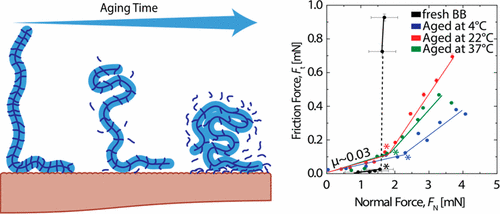当前位置:
X-MOL 学术
›
Biomacromolecules
›
论文详情
Our official English website, www.x-mol.net, welcomes your
feedback! (Note: you will need to create a separate account there.)
Unraveling the Correlations between Conformation, Lubrication, and Chemical Stability of Bottlebrush Polymers at Interfaces
Biomacromolecules ( IF 5.5 ) Pub Date : 2017-10-25 00:00:00 , DOI: 10.1021/acs.biomac.7b01063 Jimmy Faivre 1, 2 , Buddha Ratna Shrestha 1 , Guojun Xie 3 , Thierry Delair 2 , Laurent David 2 , Krzysztof Matyjaszewski 3 , Xavier Banquy 1
Biomacromolecules ( IF 5.5 ) Pub Date : 2017-10-25 00:00:00 , DOI: 10.1021/acs.biomac.7b01063 Jimmy Faivre 1, 2 , Buddha Ratna Shrestha 1 , Guojun Xie 3 , Thierry Delair 2 , Laurent David 2 , Krzysztof Matyjaszewski 3 , Xavier Banquy 1
Affiliation

|
In the present study, we monitored the conformation and chemical stability of a hydrophilic bottlebrush (BB) polymer in pure water and buffered saline solutions. We correlated these parameters to lubricating and wear protecting properties. Using the surface forces apparatus (SFA), we show that the BB polymer partially adsorbs on mica surfaces and extends half its contour length toward the aqueous media. This conformation gives rise to a strong repulsive interaction force when surfaces bearing BB polymer chains are pressed against each other. Analysis of these repulsive forces demonstrated that the adsorbed polymer chains could be described as end-attached elastic rods. After 2 months of aging at temperatures ranging from 4 to 37 °C, partial scission of the BB polymer’s lateral chains was observed by gel permeation chromatography with a half-life time of the polymer of at least two years. The thickness of the BB polymer layer assessed by SFA appeared to quickly decrease with aging time and temperature, which was mainly caused by the adsorption to the substrate of the released lateral chains. The gradual loss of the BB polymer lateral chains did not significantly impact the tribological properties of the BB polymer solution nor its wear protection capacity. The friction coefficient between mica surfaces immersed in the BB polymer solution was μ = 0.031 ± 0.002, was independent of the aging conditions, and remained constant up to an applied pressure P = 15 atm. Altogether, this study demonstrates that, besides the gradual loss of lateral chains, the BB polymer is still able to perform adequately as a lubricant and wear protecting agent over a time period suitable for in vivo administration.
中文翻译:

揭示界面处瓶刷聚合物的构型,润滑性和化学稳定性之间的相关性
在本研究中,我们监测了纯净水和缓冲盐溶液中亲水性牙刷(BB)聚合物的构象和化学稳定性。我们将这些参数与润滑和磨损保护特性相关联。使用表面力装置(SFA),我们显示BB聚合物部分吸附在云母表面,并向水性介质延伸其轮廓长度的一半。当带有BB聚合物链的表面相互挤压时,这种构型会产生强大的排斥相互作用力。对这些排斥力的分析表明,吸附的聚合物链可以描述为末端连接的弹性杆。在4到37°C的温度下老化2个月后,通过凝胶渗透色谱观察到BB聚合物的侧链部分断裂,该聚合物的半衰期至少为两年。通过SFA评估的BB聚合物层的厚度似乎随着老化时间和温度而迅速减小,这主要是由于释放的侧链吸附到基底上引起的。BB聚合物侧链的逐渐丧失并未显着影响BB聚合物溶液的摩擦学性能或磨损保护能力。浸入BB聚合物溶液中的云母表面之间的摩擦系数为μ= 0.031±0.002,与老化条件无关,并且在施加压力下保持恒定 通过SFA评估的BB聚合物层的厚度似乎随着老化时间和温度而迅速减小,这主要是由于释放的侧链吸附到基底上引起的。BB聚合物侧链的逐渐丧失并未显着影响BB聚合物溶液的摩擦学性能或磨损保护能力。浸入BB聚合物溶液中的云母表面之间的摩擦系数为μ= 0.031±0.002,与老化条件无关,并且在施加压力下保持恒定 通过SFA评估的BB聚合物层的厚度似乎随着老化时间和温度而迅速减小,这主要是由于释放的侧链吸附到基底上引起的。BB聚合物侧链的逐渐丧失并未显着影响BB聚合物溶液的摩擦学性能或磨损保护能力。浸入BB聚合物溶液中的云母表面之间的摩擦系数为μ= 0.031±0.002,与老化条件无关,并且在施加压力下保持恒定P = 15大气压。总体而言,该研究表明,除了侧链逐渐消失之外,BB聚合物在适合于体内给药的时间内仍能充分发挥润滑剂和磨损保护剂的作用。
更新日期:2017-10-26
中文翻译:

揭示界面处瓶刷聚合物的构型,润滑性和化学稳定性之间的相关性
在本研究中,我们监测了纯净水和缓冲盐溶液中亲水性牙刷(BB)聚合物的构象和化学稳定性。我们将这些参数与润滑和磨损保护特性相关联。使用表面力装置(SFA),我们显示BB聚合物部分吸附在云母表面,并向水性介质延伸其轮廓长度的一半。当带有BB聚合物链的表面相互挤压时,这种构型会产生强大的排斥相互作用力。对这些排斥力的分析表明,吸附的聚合物链可以描述为末端连接的弹性杆。在4到37°C的温度下老化2个月后,通过凝胶渗透色谱观察到BB聚合物的侧链部分断裂,该聚合物的半衰期至少为两年。通过SFA评估的BB聚合物层的厚度似乎随着老化时间和温度而迅速减小,这主要是由于释放的侧链吸附到基底上引起的。BB聚合物侧链的逐渐丧失并未显着影响BB聚合物溶液的摩擦学性能或磨损保护能力。浸入BB聚合物溶液中的云母表面之间的摩擦系数为μ= 0.031±0.002,与老化条件无关,并且在施加压力下保持恒定 通过SFA评估的BB聚合物层的厚度似乎随着老化时间和温度而迅速减小,这主要是由于释放的侧链吸附到基底上引起的。BB聚合物侧链的逐渐丧失并未显着影响BB聚合物溶液的摩擦学性能或磨损保护能力。浸入BB聚合物溶液中的云母表面之间的摩擦系数为μ= 0.031±0.002,与老化条件无关,并且在施加压力下保持恒定 通过SFA评估的BB聚合物层的厚度似乎随着老化时间和温度而迅速减小,这主要是由于释放的侧链吸附到基底上引起的。BB聚合物侧链的逐渐丧失并未显着影响BB聚合物溶液的摩擦学性能或磨损保护能力。浸入BB聚合物溶液中的云母表面之间的摩擦系数为μ= 0.031±0.002,与老化条件无关,并且在施加压力下保持恒定P = 15大气压。总体而言,该研究表明,除了侧链逐渐消失之外,BB聚合物在适合于体内给药的时间内仍能充分发挥润滑剂和磨损保护剂的作用。











































 京公网安备 11010802027423号
京公网安备 11010802027423号